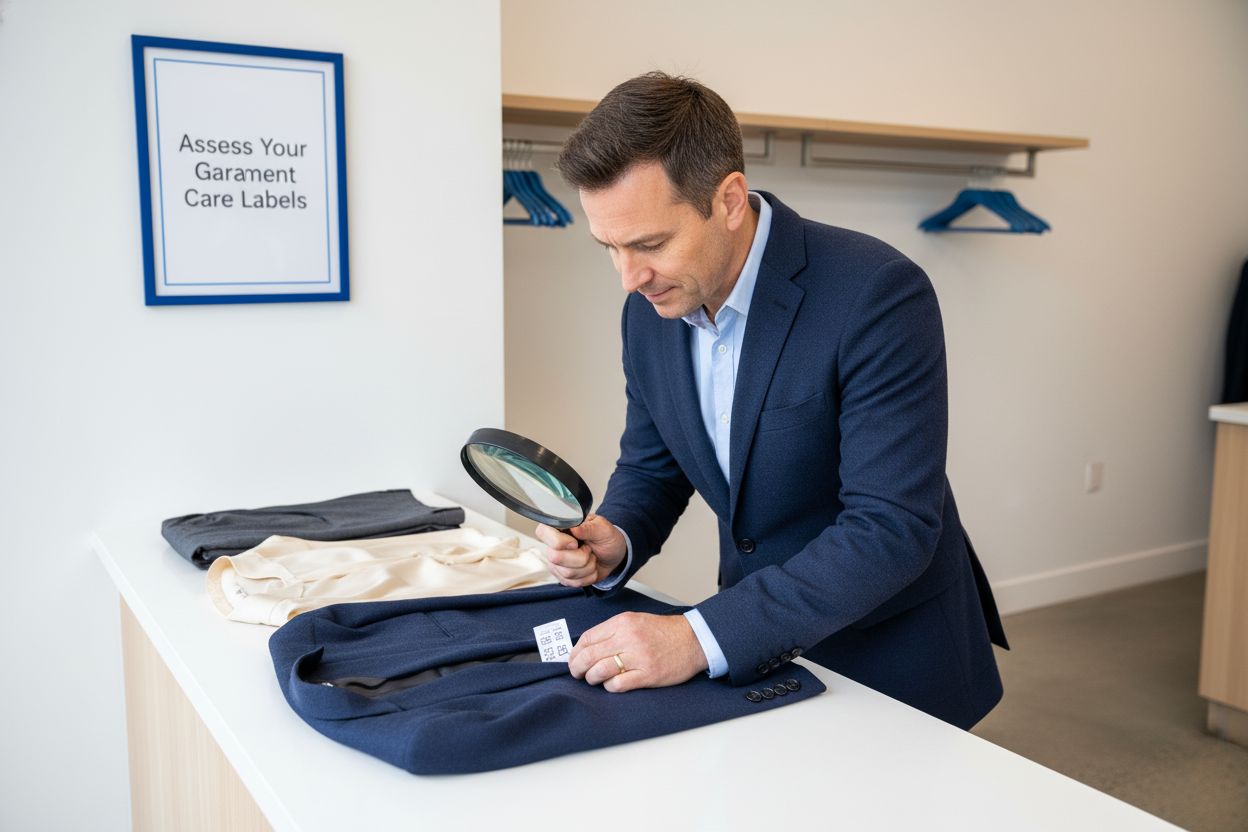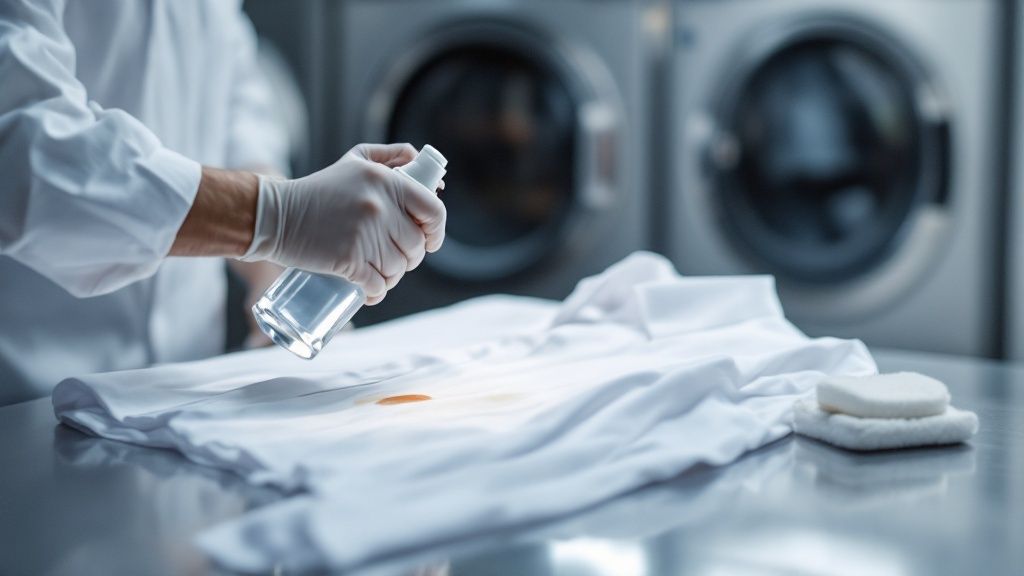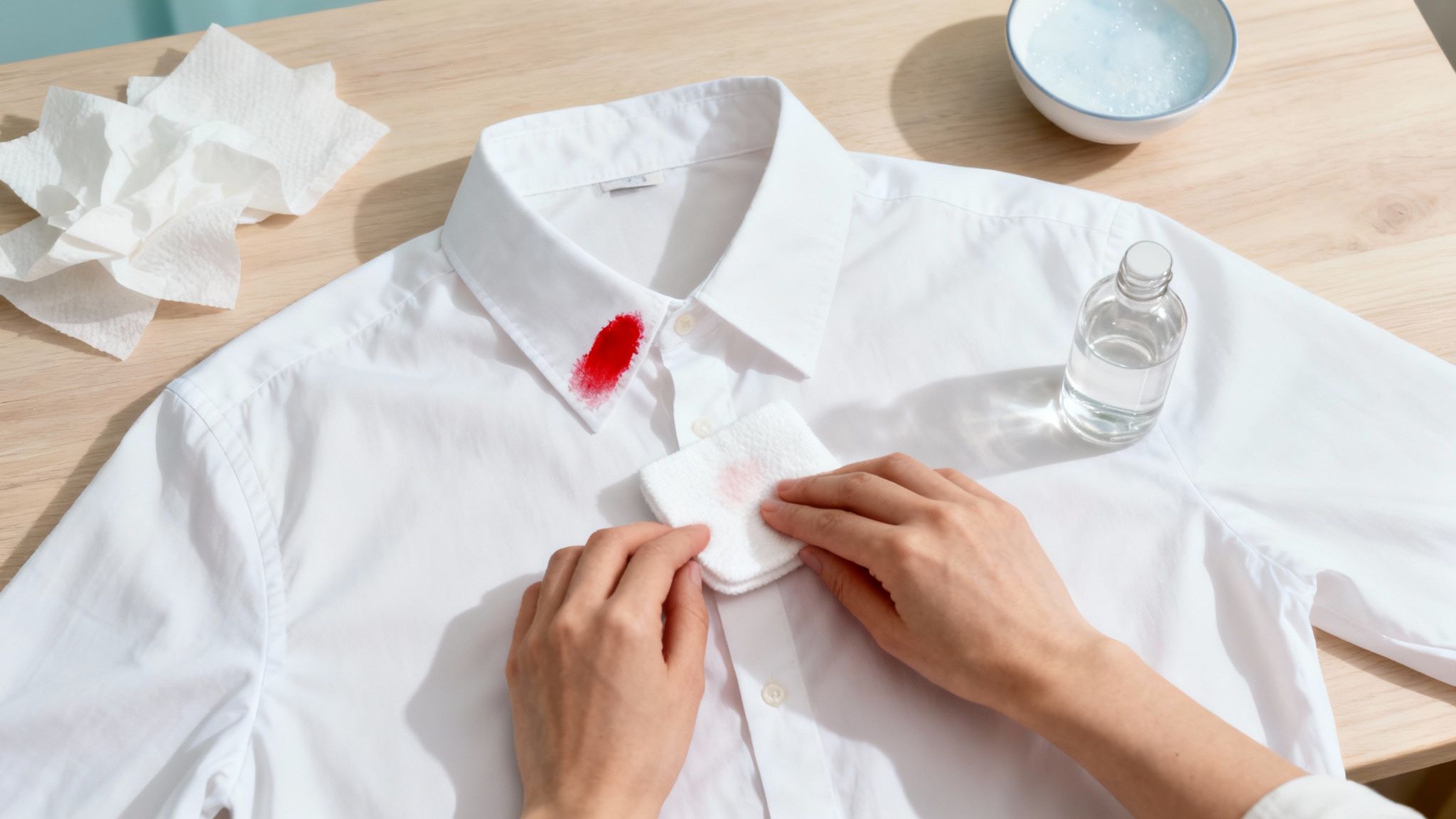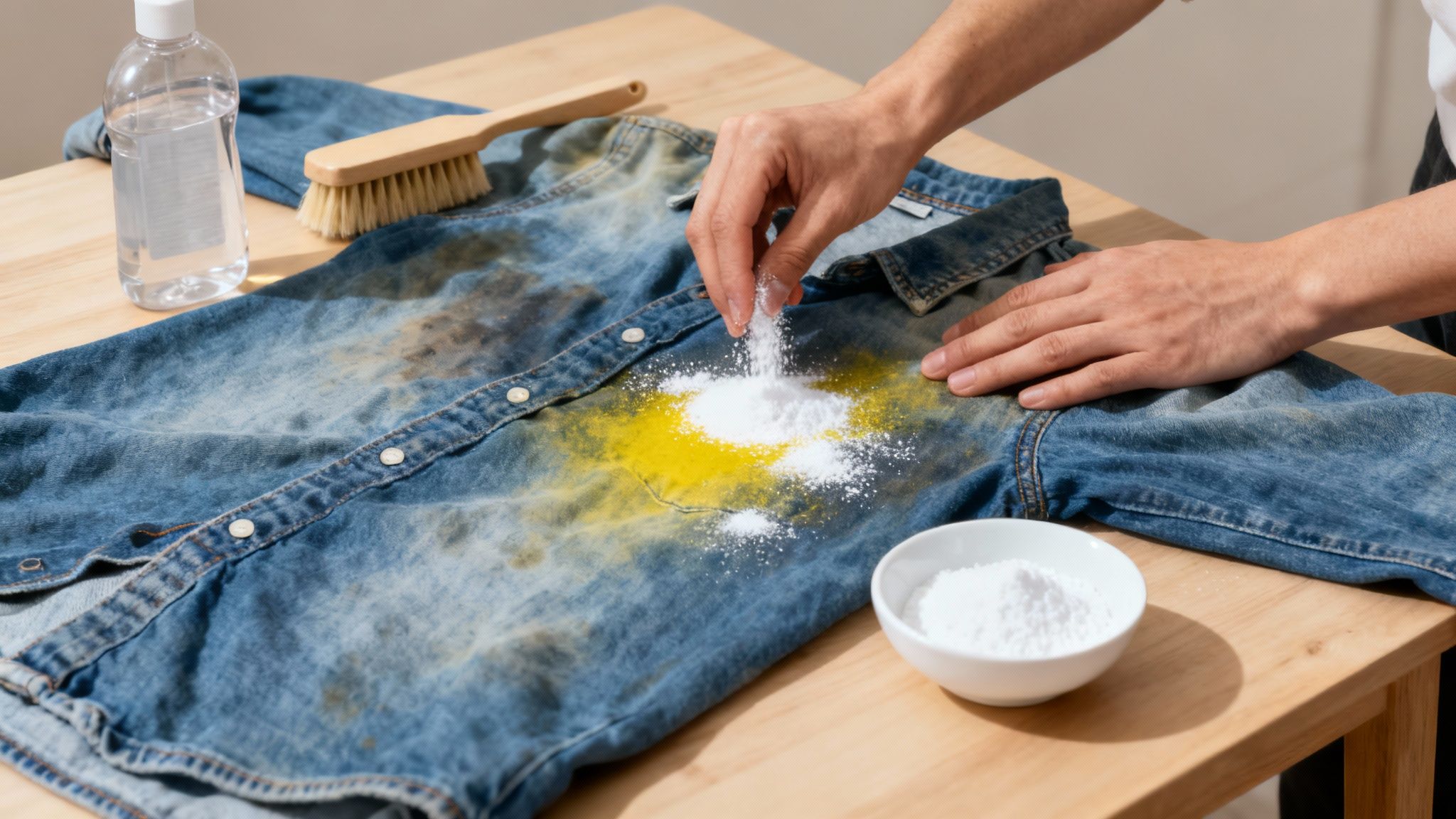Washing Clothes with Baking Soda and Vinegar Guide
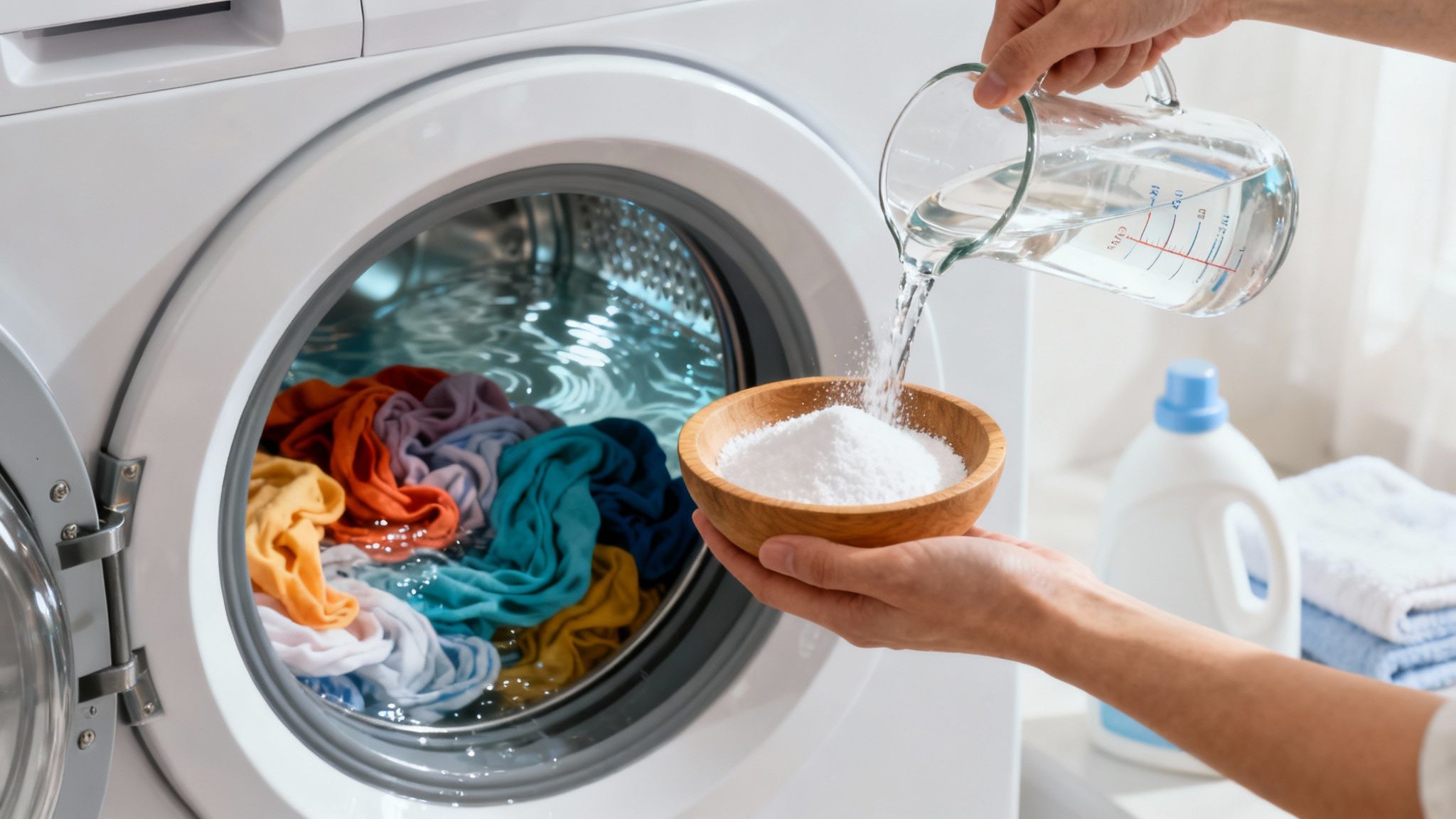
Washing your clothes with baking soda and vinegar is one of those classic, eco-friendly laundry hacks that actually works. Think of them as a one-two punch for better laundry: baking soda is a mild alkali that crushes odors and softens water, while vinegar’s acidity cuts through detergent residue, leaving your fabrics noticeably softer.
The real trick, though, is to use them in separate cycles. This way, you get the full power of each one without them canceling each other out.
The Real Power of Baking Soda and Vinegar in Your Laundry
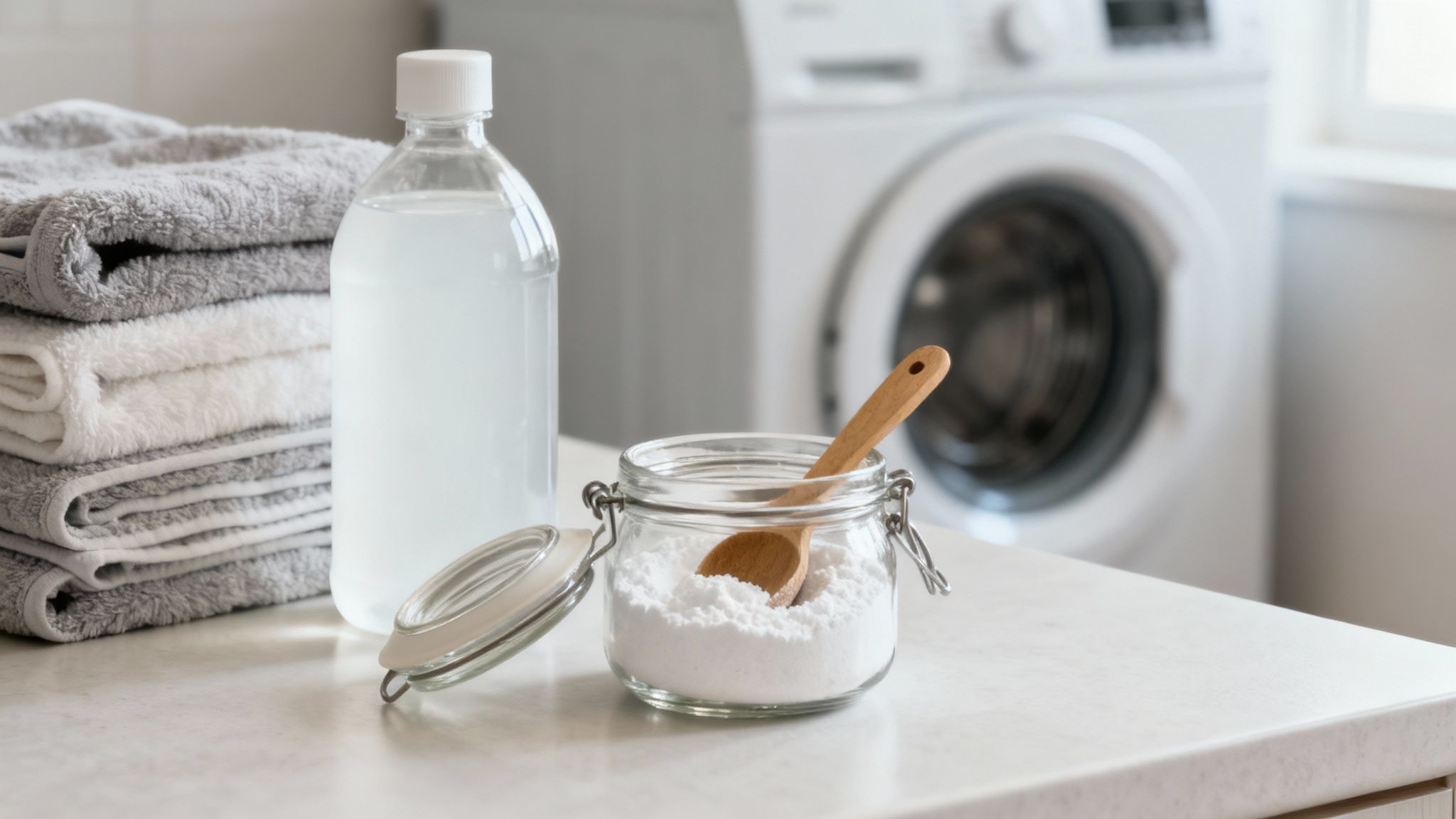
It’s easy to see why so many people are swapping pricey commercial additives for these pantry staples. They’re a simple, powerful way to upgrade your laundry routine without any harsh chemicals. But how do they really work their magic? It all comes down to some basic chemistry.
Baking soda (sodium bicarbonate) is a mild base, which means it gently raises the water's pH. This simple change helps your detergent work much more effectively. On the flip side, vinegar (acetic acid) is fantastic for neutralizing the alkaline residue that detergents can leave behind, which is exactly why it makes your clothes feel so soft.
The golden rule to remember: Never, ever mix them in the same wash cycle. Their acid-base reaction just creates saltwater, which completely neutralizes their benefits before they even get a chance to work on your clothes.
What Each Ingredient Does Best
To really get the most out of washing clothes with baking soda and vinegar, you have to understand their individual strengths. Think of them as a specialized team where each player has a very specific, important role.
Here's a quick rundown of what each one brings to the laundry room:
By knowing when to deploy each one, you can tackle specific laundry problems head-on.
- Baking Soda's Role: This is your go-to for deodorizing and brightening. Tossing some in with the wash is perfect for getting stubborn smells out of gym clothes or musty towels. As a bonus, it softens hard water, giving your detergent a serious cleaning boost.
- Vinegar's Role: This is your secret weapon for natural fabric softening. When you add it to the rinse cycle, it works to dissolve any leftover soap residue. The result? Clothes that feel soft and fresh, without that stiff feeling you sometimes get.
These natural cleaning principles aren't just for laundry, either. The same ideas apply all over the house. If you're curious, you can find similar tips in guides on natural home remedies for cleaning rugs. Once you understand their distinct jobs, you can use them strategically to get better results every single time you do a load.
How To Use Baking Soda And Vinegar Separately For Best Results

If there's one golden rule for washing clothes with baking soda and vinegar, it's this: never mix them together in the same cycle. It's a bit like cooking—timing and order are everything. Get it right, and you've got a powerhouse duo for brighter, softer, and fresher laundry. Get it wrong, and they just fizzle out and cancel each other's benefits.
The trick is to let each ingredient do its job at the perfect moment. Baking soda gets the party started by giving your detergent a serious boost, while vinegar swoops in at the end to soften fabrics and rinse away any leftover gunk.
Giving Your Wash Cycle a Boost with Baking Soda
First things first, let’s get that baking soda working its magic. Its main jobs are to neutralize stubborn odors and soften hard water, which in turn helps your detergent clean much more effectively. And honestly, it couldn't be simpler.
For a standard-sized load, you’ll want about one-half cup of baking soda.
Just toss it directly into the washing machine drum right on top of your dry clothes before you hit start. Skip the dispenser drawer for this one; you want it mingling with your laundry from the very beginning.
Now, just add your go-to laundry detergent as usual and run your favorite wash cycle. The baking soda will get to work right away, tackling odors and giving your detergent the backup it needs.
Softening Things Up with Vinegar in the Rinse Cycle
Once the main wash is done, it’s vinegar's time to shine. It acts as a fantastic natural fabric softener, cutting right through any detergent residue that can leave your clothes feeling stiff and scratchy.
Key Takeaway: Vinegar goes into the fabric softener dispenser, not straight into the drum with the clothes. This timing is crucial because it ensures the vinegar is released during the final rinse, well after the soap and baking soda have been washed away.
Measure out one-half cup of distilled white vinegar and pour it into your machine's fabric softener compartment. No dispenser? No problem. Just be ready to manually add the vinegar right as the rinse cycle begins.
The vinegar will work its softening magic, and I promise, the smell completely disappears during the final rinse. All you're left with is incredibly clean, fresh-smelling laundry.
This two-step process is the tried-and-true way to get the most out of these simple household staples. If you're looking for more natural laundry solutions, you might find our guide on how to wash clothes without detergent packed with other useful tips for your routine.
Getting the Measurements Right (and Protecting Your Washer)

While using baking soda and vinegar is a fantastic natural approach to laundry, getting the amounts right is the key to success. More importantly, a few simple safety rules will protect both your clothes and your washing machine from accidental harm. These aren't complicated guidelines, but they are essential.
For most standard laundry loads, a simple rule of thumb works perfectly. Just add about one-half cup of baking soda directly into the drum with your clothes. When the rinse cycle kicks in, pour one-half cup of distilled white vinegar into the fabric softener dispenser. This simple combination is effective without being overkill.
Critical Safety Warnings You Can't Ignore
First and foremost, the most important rule is to never mix vinegar with chlorine bleach. This combination creates toxic chlorine gas, which is a serious respiratory hazard. Always keep these two products completely separate in your laundry routine.
Another thing to keep in mind is the potential long-term effect vinegar might have on your washing machine. While it’s generally safe in small, diluted amounts, vinegar is acidic. Over time, frequent use could potentially degrade the rubber hoses and seals inside some machines.
Pro Tip: Before you make vinegar a regular part of your laundry day, take a quick look at your washing machine’s user manual. Some manufacturers specifically advise against using acidic products, and following their guidance can help you avoid any risk to your appliance's warranty.
For those times you're dealing with particularly tough buildup, you might want to try a more intensive cleaning method. You can learn more about this process in our guide on how to properly strip laundry.
Finally, ensuring your entire laundry setup is safe extends beyond just the washer. Maintaining your dryer is just as crucial for preventing household hazards. Adopting expert dryer vent cleaning tips for safer homes is a smart step toward a safer, more efficient laundry room. This holistic approach to appliance care ensures everything runs smoothly for years to come.
Targeting Tough Odors and Stains Before You Wash
Sometimes a standard wash cycle just won’t cut it, especially when you're dealing with stubborn, set-in stains or odors that seem to have a life of their own. Before you even think about starting the machine, a targeted pretreatment can make all the difference. This is where baking soda and vinegar really prove their worth, letting you tackle problem spots directly.
Think of it as giving your laundry a head start on the tough stuff. For those annoying greasy spots, sweat stains around collars, or just general grime, a simple baking soda paste works wonders. It’s a gentle abrasive that helps lift stains right out of the fabric fibers without any harsh chemicals.

Creating a Powerful Baking Soda Paste
Making this pretreatment paste is almost laughably easy. This is my absolute go-to for yellowing underarm stains on white t-shirts and the dinginess that builds up on shirt collars over time.
- Mix the Paste: In a small bowl, just mix two parts baking soda with one part water. You’re looking for a thick but spreadable consistency, kind of like toothpaste.
- Apply Directly: Gently rub the paste right onto the stained area. I like to use an old toothbrush or just my fingers to really work it into the fabric.
- Let It Sit: Now, just let the paste sit and dry on the stain for at least 15-30 minutes. After that, you can toss the garment into the wash like you normally would.
This little bit of prep time allows the baking soda to do its magic, absorbing oils and breaking down the stain before the main wash even kicks off.
Using a Vinegar Presoak for Deep Odors
For those really aggressive smells—like that mildew funk on towels you forgot in the washer (we've all been there) or the lingering campfire smoke on a favorite hoodie—a vinegar presoak is your best bet. The acetic acid in vinegar is brilliant at neutralizing the alkaline molecules that cause nasty odors in the first place.
All you need to do is fill a bucket, your sink, or even the washer tub with cool water. Add one cup of distilled white vinegar, give it a little swish, and then fully submerge the smelly items. Let them soak for at least an hour before running them through a normal wash cycle.
This presoak doesn't just cover up odors; it actually eliminates them at the source. For a deeper dive, our guide on how to get the mildew smell out of clothes has even more powerful strategies. By taking a few minutes to pretreat these tough challenges, you're setting your main wash up for a much better outcome.
Knowing When to Stick with Commercial Detergents
Look, I’m a huge fan of using baking soda and vinegar in my laundry. It’s a fantastic, natural way to give your clothes a boost. But let’s be real—it’s not a magic bullet for every single laundry problem.
Think of this combo as your laundry sidekick, not the superhero. For your everyday loads, they do an amazing job of softening fabrics and kicking odors to the curb. But when you’re dealing with a serious mess, you need to call in the big guns.
When You Absolutely Need Detergent
Sometimes, you just need more firepower. A high-quality commercial detergent is still your best bet for those really tough jobs.
Save your trusted detergent for messes like:
- Protein-based stains like blood, grass, or that mystery sweat stain on a workout shirt.
- Grease and oil stains, which need specific ingredients called surfactants to actually lift them out of the fabric.
- Heavily soiled clothes—think muddy soccer uniforms or grimy work clothes.
Modern detergents are engineered with specialized enzymes and surfactants that are designed to break down specific, stubborn stains that natural remedies just can’t tackle on their own.
Studies back this up. While baking soda and vinegar are champions at freshening and softening, they simply don't have the stain-fighting muscle of products developed specifically for fabric care. Formulations with oxygen-based pre-treaters, for example, will always outperform pantry staples on tough stains. You can dive deeper into these detergent performance comparisons on Tide.com if you're curious.
Common Questions About Using Baking Soda and Vinegar in Laundry
Even with the best instructions, trying something new in your laundry room can bring up a few questions. That's totally normal. To help you get started with confidence, we've gathered the most common things people ask about washing clothes with baking soda and vinegar. Think of this as your quick-start guide to avoiding any laundry day mishaps.
Can I Mix Baking Soda and Vinegar Together?
This is easily the most important question, and the answer is a hard no. You should never mix them in the same cycle. When you combine them, they immediately react and create what's essentially saltwater. This completely cancels out all the cleaning, deodorizing, and softening power you were trying to get in the first place.
For the best results, you have to use them separately. Here’s how:
- Baking Soda: Toss this directly into the drum with your clothes and detergent right at the start of the wash cycle.
- Vinegar: Pour this into the fabric softener dispenser. Your machine will automatically add it during the rinse cycle, which is exactly what you want.
Will My Clothes Smell Like Vinegar?
Not at all. While that jug of distilled white vinegar definitely has a strong smell, it completely washes away during the final rinse and spin. Instead of leaving behind a salad-like scent, it actually takes all the other funky odors with it, leaving your laundry smelling perfectly neutral and clean.
Your clothes will emerge from the dryer smelling fresh, not like a pickle jar. The vinegar's job is to knock out odors, and it vanishes once its work is done.
What Kind of Vinegar is Best?
For laundry, you should always stick with distilled white vinegar. It's completely clear and doesn't have any tannins—the natural plant compounds that can give other vinegars their color. This means there's zero risk of it staining your clothes, especially your whites and other light-colored items.
Definitely avoid using apple cider vinegar or other colored vinegars in your washer. They can leave behind subtle, yellowish marks on your favorite garments, and nobody wants that.
Tired of spending your weekends sorting, washing, and folding? Columbia Pike Laundry offers professional laundry and dry cleaning pickup and delivery services that give you back your time. Let us handle the laundry so you can focus on what really matters. Schedule your first pickup today!
Popular Blog Articles

Meet the Author
Daniel Logan didn’t start CPL because he loved laundry. He started it because his family was drowning in time debt, and laundry was one of the biggest weights.
Mornings were chaos with two kids under 5. Evenings felt like catch-up. And weekends? Gone to sorting socks and folding piles.
He knew his story wasn’t unique. So he built a business that gave families like his just a little bit of breathing room one load at a time.
With no laundry experience but deep tech skills, Daniel rolled up his sleeves, doing every job himself while building systems that turned it into a modern laundry service that saves customers time, simplifies their lives, and delivers reliability they can count on.
That’s where CPL began. Not from a playbook, but from pain. From one dad trying to buy back time: for himself, and for every household like his.



